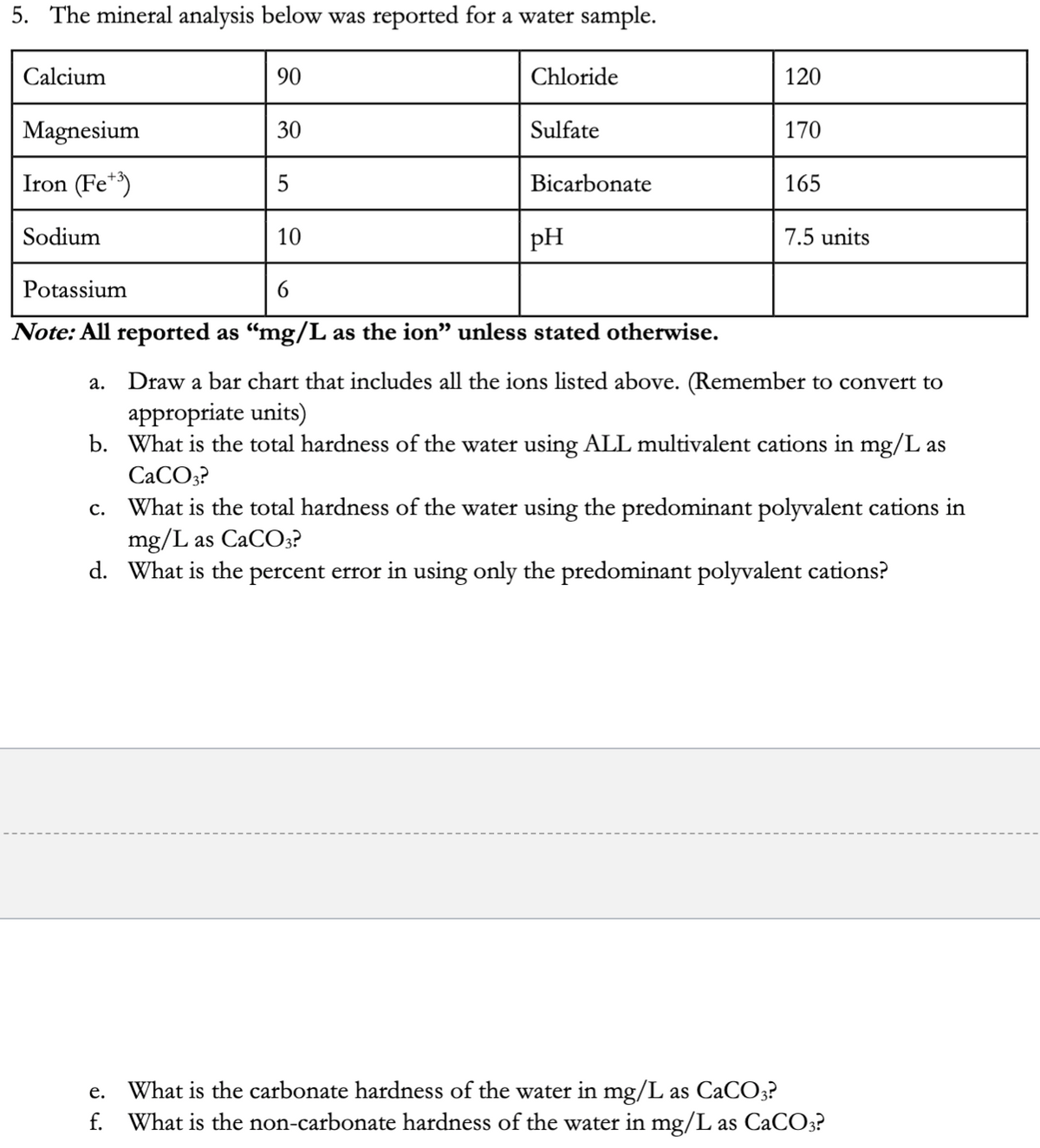5. The mineral analysis below was reported for a water sample. Calcium 90 Chloride 120 Magnesium 30 Sulfate 170 Iron (Fe**) 5 Bicarbonate 165 Sodium 10 PH 7.5 units Potassium Note: All reported as “mg/L as the ion" unless stated otherwise. Draw a bar chart that includes all the ions listed above. (Remember to convert to appropriate units) b. What is the total hardness of the water using ALL multivalent cations in mg/L as а. CACO3? What is the total hardness of the water using the predominant polyvalent cations in mg/L as CaCO3? с.
5. The mineral analysis below was reported for a water sample. Calcium 90 Chloride 120 Magnesium 30 Sulfate 170 Iron (Fe**) 5 Bicarbonate 165 Sodium 10 PH 7.5 units Potassium Note: All reported as “mg/L as the ion" unless stated otherwise. Draw a bar chart that includes all the ions listed above. (Remember to convert to appropriate units) b. What is the total hardness of the water using ALL multivalent cations in mg/L as а. CACO3? What is the total hardness of the water using the predominant polyvalent cations in mg/L as CaCO3? с.
Chemistry
10th Edition
ISBN:9781305957404
Author:Steven S. Zumdahl, Susan A. Zumdahl, Donald J. DeCoste
Publisher:Steven S. Zumdahl, Susan A. Zumdahl, Donald J. DeCoste
Chapter1: Chemical Foundations
Section: Chapter Questions
Problem 1RQ: Define and explain the differences between the following terms. a. law and theory b. theory and...
Related questions
Question

Transcribed Image Text:5. The mineral analysis below was reported for a water sample.
Calcium
90
Chloride
120
Magnesium
30
Sulfate
170
Iron (Fe**)
5
Bicarbonate
165
Sodium
10
pH
7.5 units
Potassium
6.
Note: All reported as "mg/L as the ion" unless stated otherwise.
Draw a bar chart that includes all the ions listed above. (Remember to convert to
appropriate units)
b. What is the total hardness of the water using ALL multivalent cations in mg/L as
а.
CACO3?
c. What is the total hardness of the water using the predominant polyvalent cations in
mg/L as CaCO3?
d. What is the percent error in using only the predominant polyvalent cations?
e. What is the carbonate hardness of the water in mg/L as CaCO3?
f. What is the non-carbonate hardness of the water in mg/L as CACO3?
Expert Solution
This question has been solved!
Explore an expertly crafted, step-by-step solution for a thorough understanding of key concepts.
This is a popular solution!
Trending now
This is a popular solution!
Step by step
Solved in 4 steps with 1 images

Knowledge Booster
Learn more about
Need a deep-dive on the concept behind this application? Look no further. Learn more about this topic, chemistry and related others by exploring similar questions and additional content below.Recommended textbooks for you

Chemistry
Chemistry
ISBN:
9781305957404
Author:
Steven S. Zumdahl, Susan A. Zumdahl, Donald J. DeCoste
Publisher:
Cengage Learning

Chemistry
Chemistry
ISBN:
9781259911156
Author:
Raymond Chang Dr., Jason Overby Professor
Publisher:
McGraw-Hill Education

Principles of Instrumental Analysis
Chemistry
ISBN:
9781305577213
Author:
Douglas A. Skoog, F. James Holler, Stanley R. Crouch
Publisher:
Cengage Learning

Chemistry
Chemistry
ISBN:
9781305957404
Author:
Steven S. Zumdahl, Susan A. Zumdahl, Donald J. DeCoste
Publisher:
Cengage Learning

Chemistry
Chemistry
ISBN:
9781259911156
Author:
Raymond Chang Dr., Jason Overby Professor
Publisher:
McGraw-Hill Education

Principles of Instrumental Analysis
Chemistry
ISBN:
9781305577213
Author:
Douglas A. Skoog, F. James Holler, Stanley R. Crouch
Publisher:
Cengage Learning

Organic Chemistry
Chemistry
ISBN:
9780078021558
Author:
Janice Gorzynski Smith Dr.
Publisher:
McGraw-Hill Education

Chemistry: Principles and Reactions
Chemistry
ISBN:
9781305079373
Author:
William L. Masterton, Cecile N. Hurley
Publisher:
Cengage Learning

Elementary Principles of Chemical Processes, Bind…
Chemistry
ISBN:
9781118431221
Author:
Richard M. Felder, Ronald W. Rousseau, Lisa G. Bullard
Publisher:
WILEY